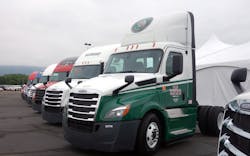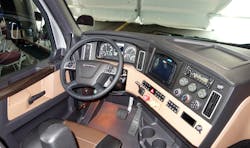COLORADO SPRINGS, CO. Daimler Trucks North America introduced its all-new 2018 Freightliner Cascadia by delivering 12 tractors carrying the colors and logos of its largest fleet customers during a kick-off event staged at the World Arena here. Officially dubbed the “New Cascadia,” it combines state-of-the-art electronics, advanced powertrain integration, new technologies and refined aerodynamics to deliver up to an 8% improvement in fuel economy compared to the current Cascadia Evolution, according to Martin Daum, DTNA president and CEO.
“That’s not just a marketing number, it’s been scientifically proven in rigorous testing to be measurable and repeatable,” Daum said. “Our initial goal [in developing the New Cascadia] was 5%, so the 8% we saw in testing was a mind boggling number.”
In addition to the fuel efficiency gains, the new truck features full-time connectivity tied into the company’s Detroit suite of remote diagnostic and data monitoring systems, making it “the largest mobile device on the road,” Daum said. It will also come to market with the next generation of Detroit advanced safety systems.
Initial production will begin in DTNA’s Cleveland, NC, and Saltillo, Mexico, plants early next year, slowing building to full production by mid 2017. The current Cascadia Evolution, which will now be called the “Classic Cascadia” will also remain in production for at least two years, according to Daum. There is a 19% spread in fuel efficiency between the base Classic Cascadia and the most efficiently speced New Cascadia, offering customers a choice in cost and performance that meets their particular operations, he said, adding that the cost spread between the basic and most advanced trucks would be $15,000.
Highlights for the new truck’s integrated Detroit powertrain start with 400-hp ratings of the Detroit DD15 or DD13 diesel engines mated to the Detroit DT12 automated mechanical transmission and new Detroit rear axles with ratios as low as 2.16. The DT12 receives a number of internal changes to reduce friction for better fuel efficiency as well as a new generation of Detroit’s intelligent powertrain management software that incorporates GPS-enabled predictive cruise control. New gear coatings and an electronic lubrication management system are among the fuel-efficiency features of the new Detroit tandem axle, which will initially be available with a 2.28 final drive ratio followed by the 2.16 ratio later in 2017.
Using the company’s dedicated wind tunnel and computer fluid design, the New Cascadia’s cab has been fine-tuned for optimal aerodynamics, according to Kary Schaefer, general manager of product marketing and strategy. It will be offered with two aerodynamic packages, one similar to the current Cascadia Evolution but with lower clearances for front and side air dams and redesigned mirror mounts, and the other an extensive AeroX package with longer side extenders, lower chassis fairings, a new front air dam design and proprietary wheel covers and fairings.
A completely redesigned interior features a wraparound dash with integral 5-in display screen, new steering wheel controls, and extensive use of soft automotive-like finishes, as well as added storage space, dimmable LED lighting and new door seals that improve cab noise levels. Options include a murphy bed bunk over a dinette area and 3M Thinsulate insulation for added noise and temperature isolation.
Drawing on an advisory panel of top technicians from its dealership network, the new model incorporated a number of their suggestions to ease maintenance and increase vehicle uptime. “You can’t beat physics – every machine has to be serviced, but you can design for quicker, better servicing,“ said Toby Faulkner, dir. of New Cascadia development. Those design elements include a single centralized compartment for all electricals including all ECUs that can be accessed from within the cab by removing a single panel without any hand tools. Frame rails have been splayed in the engine compartment for easier access to accessories, the entire HVAC system can be reached though a panel on top of the dash, and a new front bumper can be removed by one person in two minutes, according to Faulkner. Use of LEDs for all exterior lighting including headlights also reduces maintenance requirements.
Advanced safety systems available in the New Cascadia include the next generation of the Detroit Assurance suite that now offers full emergency braking on stationary objects, adaptive cruise control and lane departure warning all using a new version of a proprietary Daimler radar sensor.
While the improved fuel efficiency, driver comfort features and advanced safety systems are impressive, the new truck’s connectivity features are so extensive they require an article of their own. But in outline, DTNA is moving away from a subscription model and will instead provide five years of full-time connectivity as standard on the New Cascadia. That package will include its Virtual Technician remote diagnostics, a new Detroit Portal that will allow fleets to integrate data more easily into their own systems, and remote updating of firmware and vehicle performance parameters. An optional Detroit Connect Analytics will also be launched next year, offering fleets insights into vehicle, driver and fleet performance.
“This is a completely brand new truck, “said Richard Howard, DTNA sr. VP of sales and marketing. “With the new Cascadia, we … are raising fuel efficiency, connectivity, safety, quality and uptime performance to even greater levels, and also introducing a premium driver experience as a powerful customer benefit and driver retention tool.”
About the Author
Jim Mele
Jim Mele is a former longtime editor-in-chief of FleetOwner. He joined the magazine in 1986 and served as chief editor from 1999 to 2017.


